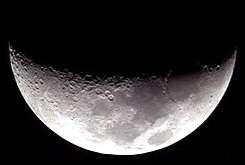Meteorites Study: Mars, Earth, Moon Grew Up In Unique Planetary Nursery

A study of meteorites suggests that Mars, the Earth and the Moon share a common composition from ‘growing up’ in a unique planetary nursery in the inner solar system. The finding could lead to a rethink of how the inner solar system formed.
In the journal Nature the international team of scientists, which includes Professor Alex Halliday from Oxford University’s Department of Earth Sciences, report how they analysed 16 meteorites that fell to Earth from Mars. They found that the amounts of neodymium-142 these contain are subtly different from those of objects found in the asteroid belt. This isotopic fingerprint is proof that the chemistry of the inner solar system was different even for elements that are hard to vapourise.
Professor Halliday said: ‘The Earth, Moon and Mars appear to have formed in a part of the inner solar system with a ratio of samarium to neodymium that is around 5 per cent more than could be found in the asteroid belt. It is this ‘family resemblance’ that we see today when we compare oceanic basalts from Earth with Moon rocks and Martian meteorites. Such differences may be the result of the erosion of planetary crusts during formation events, alternatively, this composition arose from the sorting of clouds of partially melted droplets or grains - known as ‘chondrules’.’
Earth has a long geological history of recycling the materials that make up its crust and mantle, which could help explain why its composition is different from that of other planetary bodies – it could, for example, have deeply buried reservoirs of certain elements. However Mars and the Moon are believed to have been nothing like as active during their lifespan: making it much more difficult for any theory involving material recycling to explain why their composition should differ from other planetary bodies and yet have such similarities with the composition of the Earth.
Professor Halliday said: ‘What our results suggest is that the sorting of the elements that make up these planets may have happened at a much earlier stage than had been believed. It may even be that this sorting happened in the accretion disk out of which Mars and the early Earth first formed. What we can say is that the composition of these worlds is inconsistent with them simply forming out of large ‘lumps’ of stony meteorites, like those we see today in the asteroid belt.’
A report of the research, entitled ‘Super-chondritic Sm/Nd in Mars, Earth and the Moon’, is published in Nature on 20 March 2008. Co-author Alex Halliday is Professor of Geochemistry at Oxford University’s Department of Earth Sciences and Head of the MPLS Division. The international team included scientists from the Universite Denis Diderot, France, the ETH Zurich, Switzerland and the Ecole Normale Superieure de Lyon, France.
Source: Oxford University





















